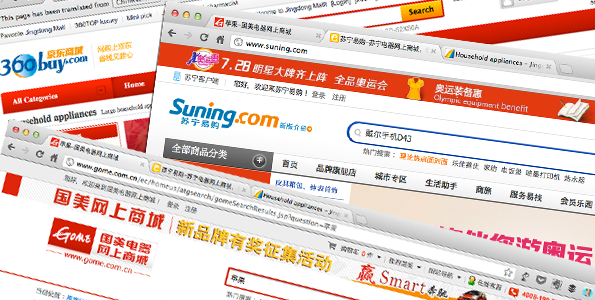I don’t own an iPad. I’ve always wanted one but probably more for the kids than anything else.
I guess I’ve just felt that I had better things to do with the cash. So price has been a barrier (especially since I have three kids!) Not anymore – and mostly because of e-commerce. Why? Because here in my second home of Shanghai they’re cheap – Gome one of China’s two leading electronics behemoths has just dropped the price on an iPad 2 to CNY 1999 (that’s just over 300 of your American Dollars) so ok now I’m getting three!
China is fast becoming one of the cheapest places to buy online as Gome, its arch-rival Suning and relatively recent e-commerce entrant 360buy.com seek to beat each other online. As they do, the incumbents are closing non-performing retail outlets (which less than five years ago accounted for over 80% of Sony’s sales in China) and cutting price across the board.
Chinese shoppers are reaping the rewards but the retailers are hurting – according to The Global Times “Suning Appliance Co, China’s largest home appliance retailer by market value, saw its net profit drop 15 % year-on-year during Q1 this year, while the profit of Gome plunged some 88% over the same period”.
Youngchinabiz.com reports that Suning saw its share value drop 10% on 16th July alone. What does this tell us?
The move to online costs hurts incumbent bricks and mortar retailers most.
I blogged about the urgent need for manufacturers to recognize and address this rapidly and I predicted that as online sales boom traditional retailers would have to fight hard to sustain their position. China’s appliance retail sector shows how global retailers will pursue price hard and they illustrate the consequences. Ultimately manufacturers can expect to foot part of the bill, if not in the search for direct contributions towards discounts, they will pay as the price positioning of their brands erode.
Manufacturers need to gear up for price competition to become more intense and for the gap between gross and net sales to widen rapidly in the coming years. If this is not yet on the radar for your business – it needs to be – and so do the huge upsides that the global re-structuring of retail offers.
In the last decade the Top 10 global retailers have doubled in size, accounting for over USD1 trillion in sales (see Deloitte’s “Global Powers of Retailing 2012”) . This has lead to a global acceleration in trade spend to fuel this expansion. Global manufacturers have felt the profit pinch and margins are at an all-time low. As the global economy slips back into recession, manufacturers will be hit harder, not just in the top line but the also in the bottom line. Its time manufacturers got smart to the potential to re-invent their retail model. And now is this time to act. Today 9% of UK retail sales are online – this will increase exponentially from now on.
So if you are a manufacturer what should you do?
Focus on your target shoppers – who are they? Where are they buying? What will make them choose you? The days of generic approaches are gone – it’s now time to create clear specific targets and chase the ones who produce the most value for your brands.
Re-calibrate your channel strategies now – look not at where you sell most today, but where you will sell most tomorrow. Seek out only those retail environments where you can really win with your target shoppers and build your route-to-market strategies to anticipate the shift in buying behavior.
Seek alternatives to price – chasing price points can never add value to your brand, nor does it guarantee a sale. Avoid the pressure to support retailer’s demands for keener price points just because they are in a pickle and focus on activities that will cement loyalty. E-commerce will be a part of this, its inevitable, so now is the time to build your competence in the virtual world as well as the bricks and mortar one.
Invest more wisely – simply put – stop supporting retailers who have no future and shift your expenditure to those who are best equipped to whether the storm. Remember that the retail model depends not just of front margins but also on back margins. This is true both offline and online so take maximum care to avoid repeating the mistakes of the past as retail evolves.
China is still considered by most as a ‘developing market’ so this massive change shows how quickly e-commerce will impact on the fastest growing markets – this is a global imperative for manufacturers not just an western market phenomenon so it’s time to act!
